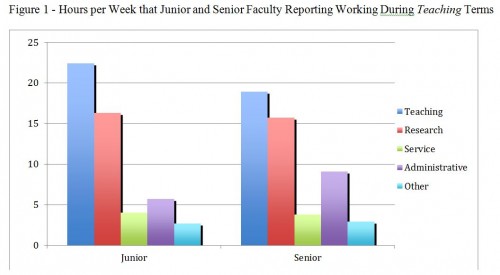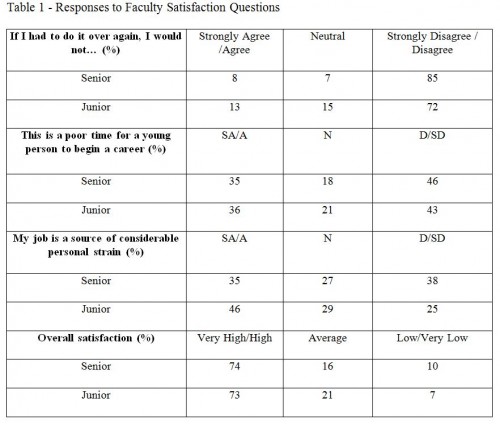It is commonly assumed that junior (pre-tenure) professors work much harder and have lower levels of job satisfaction than their more senior (tenured) peers.
A new study of Canadian university faculty, titled ‘Academic Work in Canada: the Perceptions of Early-Career Academics’ and published in Higher Education Quarterly (Jones, Weinrib, Metcalfe, Fisher, Rubens0n & Snee, 2012, volume 66, no. 2) concludes that not only is this assumption incorrect, but also that, despite the rhetoric that junior and senior academics are experiencing increasingly divergent responsibilities and pressures, there appear to be quite limited differences in almost all facets of the professional lives of junior and senior faculty in Canadian universities. We found that junior and senior faculty have similar working patterns in their teaching, research and service roles.
The Study
Data for the study were obtained from the Canadian component of the Changing Academic Profession (CAP study). The project surveyed close to 30,000 academics in 18 countries in order to obtain the perceptions of university professors on various aspects of their work. It is the largest, most comprehensive analysis of the academic profession that has ever been conducted. In the Canadian context, the findings represent the first large-scale, comprehensive foray into understanding the working lives of full-time academics employed by Canadian universities.
At the end of 2007, the Canadian CAP team contacted 6,693 potential participants across 18 universities of various size, mission and type and invited them to complete the CAP web-based survey. From this group, 1,152 individuals responded for a 17.21% response rate. The characteristics of the respondent population closely resemble the characteristics of the whole population of full-time faculty at Canadian universities in institutional type, rank, and a number of demographic characteristics, though women were slightly over-represented, making up 40.9 percent of respondents compared with 32.7 percent of full-time faculty.
This study began with the assumption that there would be substantial differences in the responses of early-career and senior faculty, and perhaps the most important finding that came from the analysis was that there were in fact very few differences. As we note in the Higher Education Quarterly article, “assistant professors generally report that they operate under similar working conditions to their more senior colleagues and possess a relatively high level of satisfaction with the majority of their professional responsibilities and functions.” However, there were differences between the two groups.
Workload
The first area of analysis focused on the amount of time that faculty reported spending on the core aspects of academic work: teaching, research, and service. While there is a common stereotype of academic life as relatively leisurely, and an assumption that early-career faculty work longer hours than their senior colleagues, especially where teaching is concerned, the findings from the CAP survey contradict both of these popular conceptions. Both junior and senior faculty report working approximately 50-51 hours per week during teaching terms and 47 hours per week during non-teaching terms. In teaching terms, junior faculty spend slightly more time on teaching-related activities while senior faculty spend more time on administrative duties. During non-teaching terms, junior faculty report spending slightly more time on research activities while senior faculty report spending more time on administrative duties.


One area of significant difference that bears mentioning, which does support some of the common perceptions alluded to previously, is the portion of teaching devoted to undergraduate courses, where junior faculty reported spending 71% of their teaching time focusing on undergraduates as compared to only 61% for their senior colleagues. This goes hand-in-hand with senior faculty spending twice as much time on doctoral teaching than junior faculty (10.9% vs. 5.5%). In this regard, the authors assume that these findings simply reflect developmental differences within academic career trajectories and that responsibility for graduate teaching increases as individuals’ transition from early to mid-career.
Satisfaction
The second important area of analysis examined the overall level of satisfaction of full-time faculty members in Canadian universities. This portion of the study included questions regarding levels of stress, personal strain and overall satisfaction with chosen career paths. In order to understand the relationship between academic rank and the level of job satisfaction of Canadian academics, rank was cross-tabulated with responses to a series of relevant questions in the CAP survey.

Perhaps the most striking idea that emerges from from these responses is that Canadian academics as a whole report extremely high levels of satisfaction with their career, particularly when compared to their colleagues in other Anglophone countries. Canadian full-time tenured academics reported considerably higher levels of overall satisfaction (74% Very High or High) than their peers in Australia (55%), the United Kingdom (47%), and the United States (63%).
Given the changing context of higher education in Canada, responding to both economic and social pressures, perhaps the most important question raised by this study is why faculty reported such high levels of job satisfaction. A number of contextual realities that affect the day-to-day life of many academics would seem to challenge this finding: student enrolment has far outpaced the growth in full-time faculty appointments, leading to more students per faculty member across the country; the level of provincial operating grants on a per student basis has decreased in all Canadian provinces; and the pressure to publish and bring in external research funding grants has increasingly put faculty research activities under a microscope. These and other trends would seem to provide ample excuses for a souring of faculty perceptions and declining satisfaction levels. However, the findings of this study suggest that while there are certainly concerns about the future of the academic profession in Canada, a strong majority continue to view their work and career decisions in a positive light.
In terms of the affect that seniority has on such perceptions, while some predictable responses emerged, a number of interesting outliers also surfaced. Two of the more expected findings was that junior faculty report higher levels of stress than senior faculty, with approximately 46% of junior faculty indicating that the job “is a source of considerable personal strain” compared with 35% for senior faculty, and slightly more junior academics indicated that if they had to “do it all over again” they would not become academics (13% vs. 8%). Clearly, the life of an early career academic is susceptible to a high degree of personal and professional instability related to establishing himself or herself in a new department, university, city, or even country. This is compounded by the journey through the tenure-track, with high expectations for publishing while balancing teaching and professional service responsibilities. However, despite the possibility for these experiences to diminish an individual’s commitment to the profession or cast a shadow over their professional life, junior faculty members still reported a very high level of overall satisfaction, at almost identical levels to their more senior colleagues; 73% of junior faculty reported Very High or High overall satisfaction, compared to 74% for senior faculty.
Conclusion and Implications
While the above findings present just a small slice of the data pie that emerged from the CAP survey, they offer a fascinating glimpse into the working lives of full-time faculty members at Canada’s universities. They also provide a solid basis for engaging with many common perceptions, and misconceptions, that help form the public understanding of the inner workings of the country’s universities. On the whole, Canada’s full-time university professors appear to benefit from a relatively stable and well-resourced working environment, regardless of rank, institutional type and province.
However, it is unfortunate that these types of discussions occur so infrequently in both Ontario and Canada. A major reason for the lack of informed discussion and debate seems to be the absence of consistent data that examines the state of the professoriate, amongst an array of other interesting data points. Given recent decisions at Statistics Canada to discontinue the type of in-depth data collection that could contribute to analysis and debate amongst policy-makers, institutional leaders and public interest groups, it is clear that it will only become more difficult to stand back and comprehensively reflect on the state of higher education in Canada.
One implication of this change for educational researchers in relation to the CAP study findings is the lack of understanding about the growing role that contingent faculty play on our university campuses, be they part-time or full-time but non-tenure track, other than a general recognition that their presence is becoming more pronounced. In addition to the findings outlined above, and examined in other related publications (Weinrib et al., forthcoming; Jones et al., forthcoming; Jones et al., 2012; Metcalfe et al., 2011; Metcalfe et al., 2011; Metcalfe, 2008) the CAP study has highlighted the need for more data and made it apparent that as educational researchers we are only scratching the surface of the trove of information that can inform public policy, institutional practice and professional understanding.
Bibliography
Jones, G., Gopaul, B., Weinrib, J., Metcalfe, A. S., Fisher, D., Gingras, Y. & Rubenson, K. (forthcoming). Teaching, research and the Canadian professoriate. In A. Arimoto, W. K. Cummings, J. C. Shin, & U. Teichler (Eds.), Teaching and research in contemporary higher education: Systems, activities and rewards. Dordrecht, The Netherlands, Springer.
Jones, G., Weinrib, J., Metcalfe, A. S., Fisher, D., Rubenson, K., & Snee, I. (2012). Academic work in Canada: Perceptions of early-career Academics. Higher Education Quarterly, 66(2), 189-206.
Metcalfe, A. S., Fisher, D., Gingras, Y., Jones, G. A., Rubenson, K., & Snee, I. (2011). Canada: Perspectives on governance and management. In W. Locke, W. K. Cummings, & D. Fisher (Eds.), Governance and management in higher education: The perspectives of the academy (pp. 151-174). Dordrecht, The Netherlands: Springer.
Metcalfe, A. S., Fisher, D., Gingras, Y., Jones, G. A., Rubenson, K., & Snee, I. (2010). How influential are faculty today? Responses from the Canadian professoriate. Academic Matters, October-November. Toronto: Ontario Consortium of University Faculty Associations (OCUFA).
Metcalfe, A. S. (2008). “The changing academic profession in Canada: Exploring themes of relevance, internationalization, and management.” In, Report of the International Conference on the Changing Academic Profession, RIHE International Seminar Reports, no. 12, pp. 57-73. Hiroshima, Japan: Research Institute for Higher Education.
Weinrib, J., Jones, G., Metcalfe, A. S., Fisher, D., Gingras, Y., Rubenson, K., & Snee, I. (forthcoming). Canada: Canadian university academics’ perceptions of job satisfaction – “…the future is not what it used to be.” In P.J. Bentley, H. Coates, I. R. Dobson, L. Goedegebuure & V. Lynn Meek (Eds.), Job satisfaction around the academic world. Dordrecht, The Netherlands: Springer.
Information on related studies can be found at www.oise.utoronto.ca/hec









